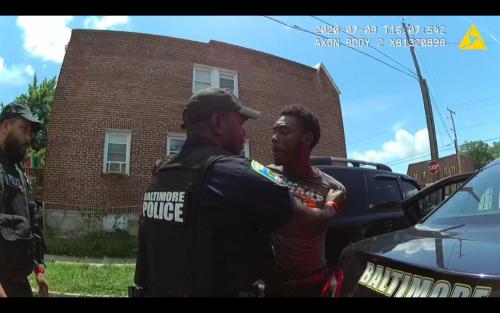Out of breath, Tyrie Washington articulated what he believed were his rights. “All right, I got my ID,” he told Rodriguez. “You’re not gonna search me.”
Washington was referring to his Fourth Amendment right against unreasonable searches and seizures. He believed that would prevent any search of his person and that all Rodriguez could lawfully do was ask for his ID.
Then Detective Israel Lopez—who pulled up with Det. Winkey moments earlier—announced “gun,” reached into Washington’s pants and removed a handgun.
“Y’all [redacted] don’t got nothing else to do?” Washington asked the three cops surrounding him. “[Than] lockin’ up people with guns on the streets?”
DAT Detective Darwin Noesi said. “Yeah.”
“Exactly,” Rodriguez chimed in. “People like you.”
The Department of African American Studies highlights Dr. Joseph Richardson, MPower & Joel & Kim Feller Professor for African American Studies and Anthropology, for being quoted and featured in Baltimore Magazine on The Gun Trace Task Force Scandal. Titled, "After The Gun Trace Task Force Scandal, BPD Established New Plainclothes Units. Are They More Of The Same?", Richardson quotes about the District Action Team (DAT) for the Baltimore Police Department and their operations to drive marked and unmarked police vehicles and wear tactical vests and other “plainclothes” gear.
DAT was established in the summer of 2017, just months after the police disbanded the federally indicted gun- and drug-seizing unit Gun Trace Task Force (GTTF), whose members stole cash and drugs, dealt drugs, and planted evidence. Then-Police Commissioner Kevin Davis announced the new DAT squads would be a different kind of proactive policing than the plainclothes cops jumping out of unmarked cars to harass and arrest: “The ‘jump-out boys’ culture was just counterproductive to everything we have to do in the crime fight,” Davis said then.
But in the 2020 final report from the Commission To Restore Trust In Policing—created in the GTTF’s aftermath—an officer noted little difference between DAT and specialized units disbanded post-GTTF: “Within a few months [of the GTTF indictment], however, the Department reorganized again, reforming plainclothes enforcement units as District Action Team (‘DAT’) squads.”
Joseph Richardson, Professor of African-American Studies and Anthropology at the University of Maryland College Park, states, “As we’ve seen across this country with the disbanding of these ‘anti-crime units,’ as soon as they get negative press . . .they’re often rebranded, repackaged, and then sold back to the public under a different name and still engaging in the same egregious practices,” he said. “That’s part of the public narrative that they sell: ‘We got rid of that.’”
This year, the Maryland State Legislature passed bills that further restricted where someone can carry a gun, raised the gun possession age to 21, and increased the maximum penalty for adults convicted of “illegal” gun possession from three years to five years. The increased maximum penalty—House Bill 0481/Senate Bill 0889—was supported by current Baltimore City State’s Attorney Ivan Bates.
Richardson, the University of Maryland professor, said that increased penalties for gun possession are part of the growing shift away from the disastrous “war on drugs” to an equally ineffective “war on guns.”
“This war on guns is very similar to the war on drugs—and the draconian approaches to it. It’s beginning to feel like the gun has now replaced crack.”
Richardson characterized the Maryland bills as “a page out of the war on drugs,” adding, “[they’re] creating and pushing for legislation, as if incarceration was the sole alternative and panacea to the gun problem. We know we’re not going to incarcerate our way out of it.”
Richardson argued that an effective violence reduction strategy is community violence intervention. Unlike policing or even GVRS—which combines community work with carceral approaches including large-scale indictments and DAT teams—violence interruption programs such as Safe Streets have been shown to be effective. In late March, a study by the Center for Gun Violence Solutions at the Johns Hopkins Bloomberg School of Public Health showed that Safe Streets has had a sustained, long-term impact on violence reduction in places where it has operated the longest.
“I don’t think policing has worked up until now, so why not invest in another alternative, which seems to be working if we put the right resources into it?” Richardson said.
Soderberg reports on cops, guns, and drugs. He is the co-author of the book, I Got a Monster: The Rise and Fall of America’s Most Corrupt Police Squad, which was made into a documentary this year.
Photo Credits:
Body-Worn Camera footage of Tyrie Washington's arrest in July 2020. —BWC footage provided to 'Baltimore' magazine
Joseph Richardson, a professor of African-American Studies and anthropology at the University of Maryland College Park. —Courtesy of the University of Maryland



